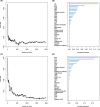Multicomponent prediction of 2-year mortality and amputation in patients with diabetic foot using a random survival forest model: Uric acid, alanine transaminase, urine protein and platelet as important predictors
- PMID: 37743574
- PMCID: PMC10824700
- DOI: 10.1111/iwj.14376
Multicomponent prediction of 2-year mortality and amputation in patients with diabetic foot using a random survival forest model: Uric acid, alanine transaminase, urine protein and platelet as important predictors
Abstract
The current methods for the prediction of mortality and amputation for inpatients with diabetic foot (DF) use only conventional, simple variables, which limits their performance. Here, we used a random survival forest (RSF) model and multicomponent variables to improve the prediction of mortality and amputation for these patients. We performed a retrospective cohort study of 175 inpatients with DF who were recruited between 2014 and 2021. Thirty-one predictors in six categories were considered as potential covariates. Seventy percent (n = 122) of the participants were randomly selected to constitute a training set, and 30% (n = 53) were assigned to a testing set. The RSF model was used to screen appropriate variables for their value as predictors of 2-year all-cause mortality and amputation, and a multicomponent prediction model was established. Model performance was evaluated using the area under the curve (AUC) and the Hosmer-Lemeshow test. The AUCs were compared using the Delong test. Seventeen variables were selected to predict mortality and 23 were selected to predict amputation. Uric acid and alanine transaminase were the top two most useful variables for the prediction of mortality, whereas urine protein and platelet were the top variables for the prediction of amputation. The AUCs were 0.913 and 0.851 for the prediction of mortality for the training and testing sets, respectively; and the equivalent AUCs were 0.963 and 0.893 for the prediction of amputation. There were no significant differences between the AUCs for the training and testing sets for both the mortality and amputation models. These models showed a good degree of fit. Thus, the RSF model can predict mortality and amputation in inpatients with DF. This multicomponent prediction model could help clinicians consider predictors of different dimensions to effectively prevent DF from clinical outcomes .
Keywords: diabetic foot inpatients; longitudinal cohort; mortality and amputation; multicomponent prediction model; random survival forest model.
© 2023 The Authors. International Wound Journal published by Medicalhelplines.com Inc and John Wiley & Sons Ltd.
Conflict of interest statement
The authors declare they have no conflict of interest.
Figures


Similar articles
-
The amputation and mortality of inpatients with diabetic foot ulceration in the COVID-19 pandemic and postpandemic era: A machine learning study.Int Wound J. 2022 Oct;19(6):1289-1297. doi: 10.1111/iwj.13723. Epub 2021 Nov 24. Int Wound J. 2022. PMID: 34818691 Free PMC article.
-
MRI-based random survival Forest model improves prediction of progression-free survival to induction chemotherapy plus concurrent Chemoradiotherapy in Locoregionally Advanced nasopharyngeal carcinoma.BMC Cancer. 2022 Jul 6;22(1):739. doi: 10.1186/s12885-022-09832-6. BMC Cancer. 2022. PMID: 35794590 Free PMC article.
-
Establishment and Reliability Evaluation of Prognostic Models in Diabetic Foot.Altern Ther Health Med. 2023 Nov;29(8):534-539. Altern Ther Health Med. 2023. PMID: 37678850
-
Risk prediction models for diabetic foot ulcer development or amputation: a review of reviews.J Foot Ankle Res. 2023 Mar 16;16(1):13. doi: 10.1186/s13047-023-00610-6. J Foot Ankle Res. 2023. PMID: 36922851 Free PMC article. Review.
-
FusionSegNet: Fusing global foot features and local wound features to diagnose diabetic foot.Comput Biol Med. 2023 Jan;152:106456. doi: 10.1016/j.compbiomed.2022.106456. Epub 2022 Dec 21. Comput Biol Med. 2023. PMID: 36571939 Review.
Cited by
-
Analysis of clinical characteristics in patients with diabetic foot ulcers undergoing amputation and establishment of a nomogram prediction model.Sci Rep. 2024 Nov 14;14(1):27934. doi: 10.1038/s41598-024-78215-7. Sci Rep. 2024. PMID: 39537768 Free PMC article.
-
Prediction models for amputation after diabetic foot: systematic review and critical appraisal.Diabetol Metab Syndr. 2024 Jun 10;16(1):126. doi: 10.1186/s13098-024-01360-6. Diabetol Metab Syndr. 2024. PMID: 38858732 Free PMC article. Review.
References
-
- GBD 2015 Risk Factors Collaborators . Global, regional, and national comparative risk assessment of 79 behavioural, environmental and occupational, and metabolic risks or clusters of risks, 1990–2015: a systematic analysis for the global burden of disease study 2015. Lancet. 2016;388(10053):1659‐1724. - PMC - PubMed
-
- Saeedi P, Petersohn I, Salpea P, et al. Global and regional diabetes prevalence estimates for 2019 and projections for 2030 and 2045: results from the international diabetes federation diabetes atlas, 9(th) edition. Diabetes Res Clin Pract. 2019;157:107843. - PubMed
Grants and funding
LinkOut - more resources
Full Text Sources
Miscellaneous

